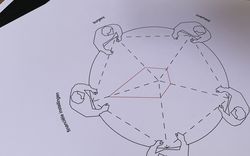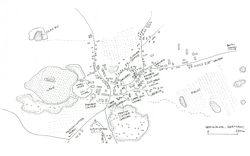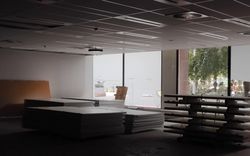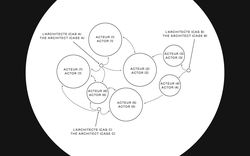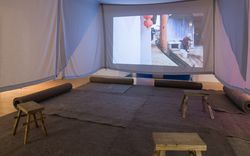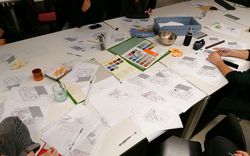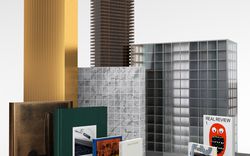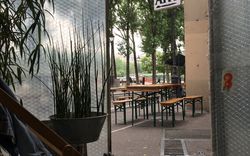The Context Complex
Andrew Scheinman contextualizes a weighty word
The word “context,” in architecture, has always been meaningless. Used alone, it is malleable, an empty signifier—it bears whatever discursive weight architects ask of it. Context might suggest the physical conditions of a site, the topographical, geographical, or ecological setting from which a building is meant to be derived. It might also, or instead, allude to a set of social conditions dependent on history, memory, culture, or any of a host of hollow words themselves lexically ambiguous. Context might denote the existing urban fabric, the poetic texture of a city or landscape. It might refer to a prescriptive and detailed architectural style, or maybe a pluralist acceptance of a few colliding or anachronistic styles. It might ignore physical, social, or stylistic concerns altogether, eluding clarity even as an umbrella term. The word might simply capture a sensory or phenomenological experience: what a place looks like, sounds like, feels like, smells like, and, sure, tastes like.1 The only thing this banal, disyllabic word does consistently denote is something, anything at all, that an architect should pay attention to in the design process, something that is expressly not the project at hand. Relational by its very nature, the word context means nothing—that is, what it describes is not contextual to anything in particular—until an architect calls it by its name. Context is precisely, intrinsically negative—an incomplete whole waiting, from the moment it is defined as such, for a heretofore missing building.
All the same, the word and its kaleidoscope of uses have been a hinge on which architecture, urbanism, and the collision of these two programs have turned for the better part of a century. Despite—or, perhaps, because of—its mess of a disciplinary definition, generations of navel gazers have spent their careers spilling ink to pin it down. The journal Oppositions, launched in the heyday of American postmodernism by some of its most influential names, staked the discipline itself on refuting the very premise of contextual architecture, or at least on questioning whether architects should actively pay context any mind.2 Later, in 1992, an issue of Lotus dedicated in part to contextualism struck back, coming to the conclusion that yes, context remains crucial and yes, architects and theorists should therefore continue to unpack it.3 Evidently it was Oppositions’ position that stuck: just after Lotus vied for the lasting life of the word, the zeitgeist largely dropped it, at least by name. Three years later, Rem Koolhaas epitomized the dismissal with a succinct “fuck context,”4 and in the two decades since, the word and the debate surrounding it has, as architectural historian Esin Kömez Dağlıoğlu documents, largely disappeared from the discourse. Recently, however, a quiet wave of new publications and small-scale practices that reject that rejection has been resuscitating the contextualist program, sometimes by using any of a number of proposed synonyms, “field,” “site,” and “instauration” among them.5 What the word context comes to mean this time around may say more about the particular identities of those architects doing the contextualizing than on any new condition in and of itself.
Contextualism, as a design strategy, is nothing new to today: tracts on the concept date back centuries, if not always verbatim, then in spirit. An early modern iteration was the Renaissance decorum, a visual coherence between site and building based on material use and ornamentation.6 Then there was genius loci, or “spirit of the place,” reappropriated from classical Roman religion by the eighteenth-century English poet Alexander Pope in an epistle on garden design. Evoking what was understood in antiquity to be a literal spirit—a supernatural animal, elf, or fairy that acted as local guardian or custodian—Pope advised designers to “consult the genius of the place in all,” affirming the mystical, inscrutable quality of context in architecture.
The word context itself came to prominence only much later, with Robert Venturi, who in his 1950 master’s thesis declared, circuitously, that “existing conditions around the site that should become a part of any design problem should be respected.” Context, in short, “is what gives a building its meaning.”7 Expanding this thesis into his 1966 Complexity and Contradiction in Architecture, Venturi proposed that new buildings are but pieces of a composite urban fabric—mere fragments of a “difficult whole”—and should be designed as such. Their form and position, marrying new and old, should reflect a modesty the modern architecture of his time dearly lacked.8
Indeed, Venturi’s use of the word here was reactionary, embedded in the generational critique of modernism that would become postmodernism. When Venturi was a graduate student at Princeton, the dominant paradigm in Western architectural pedagogy was the modernist tabula rasa. Architects were to flatten landscape, culture, and social life underneath a blanket of universalizing function and form, ushering in a utopian age by force of will, benevolence, and expertise. Design, in turn, was to be stripped of ornament, based only on representing “eternal truths” assumed to be common to all humanity, site-specificity notwithstanding. In the International Style famously sanctioned by the Museum of Modern Art in 1932,9 buildings would be wholly independent of the land they appeared on, expressive only of the machine age. This and this aesthetic revolution alone would, committed modernists believed, slip the lower classes from the surly bonds of destitution, their improperly designed architectures damning them to the social status quo. Existing conditions were little more than impediments to social progress—something the seer-like architect should do away with, however regrettably, in the necessary process of what geographer and urban theorist David Harvey calls “creative destruction.”10
Denise Scott Brown would later elaborate on the critique her partner Venturi lodged with his disciplinary coinage: “Con-text” by its very definition implies a “text” at its centre. What surrounds that text is less agential than inert or passive.11 The architect alone, the modernist movement held, would supply text; context was merely backdrop, the stage setting for their heroic acts.12
After two world wars, however—after Hiroshima and Auschwitz, the two signature death knells of technological liberation—the Western world had had quite enough creative destruction. Led by the economic and cultural hegemony of the United States, the postwar West hedged its stability on capitalistic solutions, and, in turn, North American modernists began to hollow their designs of most any emancipatory ideals. Their buildings’ sleek edges and spare spaces, once paragons of revolution by architectural means, were increasingly seen as symbolic only of prosperity and power—window dressing for the status quo. By the mid-1960s, modernist designers were roundly criticized, as Harvey would later summarize, for building “impeccable images of power and prestige for publicity-conscious corporations and governments” and, in their designs of housing projects like Pruitt-Igoe in St. Louis, “symbols of alienation and dehumanization.”13 Jane Jacobs, for one, pinned a number of creatively destructive projects as, even at their best, presumptuous, oversimplified, and detached from the diversity and complexity of city life.14 More subtly, perhaps, Bernard Rudofsky provided the architectural discipline itself with an alternative to its hubris. Through a seminal 1964 exhibition at the Museum of Modern Art, Rudofsky guided his audience, a class of New York experts, toward the humility of a “non-pedigreed” and vernacular “architecture without architects,” coyly adding that anonymous builders, unlike professionals, “rarely subordinate the general welfare to the pursuit of profit and progress.”15
So for Venturi and Scott Brown, paying attention to the context of a site was a kind of mid-century modesty—the end of the stale, subservient, and sold-out heroism of modernism and the beginning of something more democratic. Or, at least, that was its promise. Indeed, what they set out to learn in their influential 1968 study of Las Vegas was no less than “a new receptivity to the tastes and values of other people and a new modesty in our designs and in our perception of our role as architects in society.”16 The way to go about this, for Venturi and Scott Brown, was to observe and exalt a visual language well understood by everyday Americans—the commercial vernacular of pop culture and consumerism—and then to reproduce its signs and symbols, in its own language, as facades. Their job as architects, they contended, was less to correct for mass culture’s crudeness, as their modernist forebears aimed to do, than to accommodate it.
Like Venturi and Scott Brown, Colin Rowe sought a contextual remedy to professional hubris but centred his definition of the word on a more formal urban “texture,” calling his approach contexturalism. Denigrating the modernist tendency to design with what he saw as totalitarian rigidity, Rowe proposed a compromise between the modern and traditional city—a “radical middle” between the new and “the known, perhaps mundane and, necessarily, memory-laden context from which it emerges.”17 To respond to context was less to accommodate mass culture on its own terms than to accept the eclecticism, fragmentation, and heterogeneity of form that urban fabrics build up over time and to reinterpret it in responsive set pieces. Rather than razing or aping what already exists, Rowe argued, the architect should respect the intuitive responses of traditional builders to their contexts by infilling, completing, or subtracting from their work. His was a formal context, a series of urban types to be found in the city and then stitched together anew as composite buildings.
In Europe, meanwhile, modernism and its aftermath played out a little differently. Cities across the continent had been demolished by war, revived by so-called economic miracles, and, by mid-century, were in dire need of reconstitution. This left plenty of room for restoration and renewal programs alike, but above all it left cities in want, for the sake of cultural continuity, of their prewar urban fabrics. Historical revivalism was therefore commonplace by the 1950s, less the repurposing of symbols or type it would become in North America than the wholesale restitution of traditional building styles. Ernesto N. Rogers, editor of Casabella from 1953 to 1965, found this architecture impotent, and in his first editorial, took both this “demagogic folklorism” and the modernist break with history it opposed to task.18 Both programs, he argued, were obsolete and regressive: neither the deep-rooted traditions of his Italian homeland nor the ongoing revolution of modernism could be well expressed through a reduction of architecture into form alone. The architect should instead court the ambiente of their site—the cumulative cultural experiences of the city, which, though fleeting in nature, manifest over decades through piecemeal design. In this way, context was, for Rogers, phenomenological at its core. And it was this phenomenological facet of the concept that his student Aldo Rossi carried on and expanded upon, drawing as well on the Roman genius loci, in introducing the neologism locus in his 1966 L’architettura della città. Not unlike the divine protective spirit, locus, as Rossi defined it, should be seen as something local and alive—an ephemeral alternative to the sterile “making of a scene” that the static notion of context asks of architects. It is a relationship, simply put, “between a certain specific location and the buildings that are in it.”19 Akin to the word context, locus is deliberately less object-oriented and more dynamic, enveloping text within.
Though Venturi and Scott Brown, Rowe, and Rossi often contradicted one another—the context debate was indeed, as Kömez Dağlıoğlu notes, multiphonic at its origins20—their ongoing critiques of modernism came to be seen as united through two climactic exhibitions in Italy, in 1978 and 1980. The aforementioned practices and their versions of context appeared side by side first at Roma Interrotta, which invited twelve architects to reimagine the urban development of an “interrupted” Rome, and then again two years later, at the first Venice Architecture Biennale, titled The Presence of the Past. Despite the underlying diversity on display in, for instance, the latter’s Strada Novissima, a regimented street lined with twenty different architects’ facades, it was the very coalescence of contextualist approaches that predicted the deathblow of the concept.21 In the decade running up to the exhibitions, critics of postmodern aesthetics, many of whom had remained loyal to the emancipatory promise of modernism, increasingly saw contextualism as a visual valorization of capitalist production. To this opposition—driven by a cast of “critical architects” writing in Oppositions—contextualism was little more than ironic facadism: at best, its architecture did indeed respond to the spirit of place, but more often it manifested as pastiche that, like the worst of modernism before it, simply papered over an oppressive status quo with vacant visual nods. In the shallow scenography of the two exhibitions—which, as stage-set venues by their very nature, did the contextualists no favours—critics found a coherent target. Famously, Kenneth Frampton, then an editor of Oppositions, resigned from the Biennale curatorial team in opposition to the selection of the American exhibitors, whose embrace of populism he feared would legitimize the conflation of mass culture with the commodifying machinery of liberal capitalism.22
Calling for change, critics offered alternatives to the architectural approaches shown in Rome and Venice. Frampton, for one, proposed eschewing “simple-minded attempts to revive the hypothetical forms of a lost vernacular” for an architecture that responds to a more tactile understanding of context—that is, to topography, climate, light, and tectonic form.23 Peter Eisenman, another Oppositions editor, went further, arguing for an architectural “autonomy” based by and large on the deliberate ignorance of existing conditions.24 K. Michael Hays landed somewhere in between—that is, between a contextual architecture that “reconfirms the hegemony of culture and helps to assure its continuity” and an autonomous architecture that, reduced to pure form, “has disarmed itself from the start, maintaining its purity by acceding to social and political inefficacy.”25 By 1988, the critique had become concise: to Mark Wigley and Philip Johnson, curators of the Deconstructivist Architecture exhibition at the Museum of Modern Art, contextualism was often “an excuse for mediocrity, for a dumb servility to the familiar.”26 What they offered in its place was less a movement than a collection of architects, including Koolhaas and Eisenman, who embodied autonomy and embraced, in lieu of context, the recentring of building itself. The text, simply put, would be supplied by the architect once more, lest the capitalist hegemony find its champion in a manufactured vernacular.
What has happened, however, in these last two decades without a context debate, is that the capitalist hegemony found its champion anyway, in architects themselves. With all the weight placed on authorship, autonomy relied on the authors’ good faith to resist political and economic forces, a good faith that faded as the criticality it required grew increasingly obsolete, irrelevant, and coded.27 Autonomy, oppositional to contextualism by its nature, was tossed aside for instrumentality, a paradigm shift Koolhaas personified in posing that “some of our most interesting engagements are uncritical, emphatic engagements, which deal with the sometimes insane difficulty of an architectural project to deal with the incredible accumulation of economic, cultural, political but also logistical issues.”28 Context, now, was in the conversation, but nameless, understood only as issues for a professional to overcome. By producing “freestanding commoditized objects” with a pronounced and accepted inability to effect any lasting change, architects like Koolhaas learned to “ignore contextual concerns since the purpose of their pragmatism is to allow them to operate in different territories under contradictory political regimes and social conditions.”29
As architects today move to integrate contextualist programs once more, it is worth addressing the one thing the twentieth-century movement never did quite broach: that is, what defines the discipline itself. Context, a concept labelled as such by architects in the design process, does indeed acknowledge difference and turn hubristic designers into humble, well-meaning researchers. It does this, however, without acknowledging that it is a shadow cast by professionals, a group defined by the same social, economic, and political frameworks and hierarchies as the contexts it studies. Indeed, as Bryony Roberts recently noted, “Bodies carry histories, wittingly or not. Every supposedly impartial observer is entangled with the cultural biases and political struggles of their context.”30 Little more than varnish for the often-questionable enterprise of architecture, the word context in fact ignores the context of its own making. But if architects willingly collapse it into its counterpart, text—if they do question the enterprise of architecture alongside architecture itself—then the hall of mirrors shatters. What is left of context, when contextualized, is only the broadest, most basic meaning of the word: it is the complex structure that puts architecture, as a discipline, in its place.
-
For more on the imprecise use of the word in architecture, see Sandy Isenstadt, “Contested Contexts,” in Site Matters: Design Concepts, Histories and Strategies, eds. Carol Burns and Andrea Kahn (London: Routledge, 2005), 157–159. ↩
-
Produced by the Institute for Architecture and Urban Studies and published from 1973 to 1984, Oppositions was concerned primarily with, as K. Michael Hays writes, “the essential contradictions between autonomy—its self-organization into a body of formal elements and operations that separate it from any particular place and time—and its contingency on, even determination by, historical forces beyond its control.” In summarizing the journal’s editorial position, Hays skirts the question of whether or not to attend to these uncontrollable forces, instead offering that “One should ask not whether architecture is autonomous, or whether it can willfully be made so, but rather how it can be that the question arises in the first place, what kind of situation allows for architecture to worry about itself to this degree.” K. Michael Hays, “The Oppositions of Autonomy and History,” in Oppositions Reader: Selected Readings from a Journal for Ideas and Criticism in Architecture, ed. K. Michael Hays (New York: Princeton Architectural Press, 1998), ix. ↩
-
Lotus 74, La memoria dell’architetto/The Memory of the Architect (November 1992). ↩
-
Though this is far from an actual mantra. Fleshed out, the quote reflects the antagonism Koolhaas saw at the time between big and small in the city, an opposition between architecture and urbanism: “Together, all these [architecture-historical] breaks—with scale, with architectural composition, with tradition, with transparency, with ethics—imply the final, most radical break: Bigness is no longer part of any urban tissue. It exists; at most, it coexists. Its subtext is fuck context.” Rem Koolhaas, Bruce Mau, and Hans Werlemann, S,M,L,XL, ed. Jennifer Sigler (New York: Monacelli Press, 1995), 502. ↩
-
Esin Kömez Dağlıoğlu notes that, as of 2015, little critical writing had been published on the “context debate” since the 1990s. Esin Kömez Dağlıoğlu, “The Context Debate: An Archaeology,” Architectural Theory Review 20, no. 2 (2015): 266–279. Of the various publications that aim to reignite and update a conversation on contextualism, see in particular Tom Avermaete, Véronique Patteeuw, Léa-Catherine Szacka, and Hans Teerds, eds., OASE 103, Critical Regionalism Revisited (2019); and Bryony Roberts, ed., Log 48, Expanding Modes of Practice (Winter/Spring 2020). ↩
-
See Michael Hill and Peter Kohane, “Site Decorum,” Architectural Theory Review 20, no. 2 (2015): 228–246. ↩
-
Robert Venturi, “Context in Architectural Composition: Excerpts from M.F.A. Thesis, Princeton University, 1950,” in Complexity: Design Strategy and World View, eds. Andrea Gleiniger and Georg Vrachliotis (Basel: Birkhäuser, 2008), 15. ↩
-
Robert Venturi, Complexity and Contradiction in Architecture (New York: Museum of Modern Art, 1966). ↩
-
Alfred H. Barr, Henry-Russell Hitchcock, Philip Johnson, and Lewis Mumford, Modern Architecture: International Exhibition, New York, Feb. 10 to March 23, 1932, Museum of Modern Art (New York: Museum of Modern Art, 1932), exhibition catalogue. ↩
-
David Harvey marks the tragic maelstrom of “creative destruction” and “destructive creation” as internal to the Enlightenment project from Goethe’s Faust up through Mao. “You simply cannot make an omelette without breaking eggs,” the argument goes. This is, however, only a partial, if dominant, view of the modernist movement. As historian of modern architecture Sandy Isenstadt notes, “Modernism was not immune to thinking about context,” as, for instance, European architects consistently treated their historic city centres as sacrosanct, and, indeed, as Harvey suggests, “disregard of existing fabric” dates back well before even nineteenth-century Haussmannization. Nonetheless, it is, as Harvey and Andreas Huyssen posit, the vision of modernism that many postmodernists set out to oppose in their work. See David Harvey, The Condition of Postmodernity: An Enquiry into the Origins of Cultural Change (Cambridge, MA; Oxford: Blackwell, 1990), 16; Isenstadt, “Contested Context,” 161; and Andreas Huyssen, “Mapping the Postmodern,” New German Critique 33, Modernity and Postmodernity (Autumn 1984): 5–52. ↩
-
Denise Scott Brown, “Context and Complexity,” in Complexity, Gleiniger and Vrachliotis, 24–34. The article draws on an earlier essay in the aforementioned Lotus: “Talking about Context,” Lotus 74 (November 1992): 125–128. ↩
-
For more on the mythology of heroism at the heart of modernity, see Harvey, The Condition of Postmodernity, 20–33. ↩
-
Harvey, The Condition of Postmodernity, 36. The latter phrase is quoted by Harvey from Andreas Huyssen, “Mapping the Postmodern,” 14. ↩
-
Jane Jacobs, The Death and Life of Great American Cities (New York: Random House, 1961). ↩
-
Bernard Rudofsky, Architecture Without Architects: A Short Introduction to Non-Pedigreed Architecture (New York: Museum of Modern Art, 1964), exhibition catalogue. ↩
-
Robert Venturi, Denise Scott Brown, and Steven Izenour, Learning from Las Vegas: The Forgotten Symbolism of Architectural Form, rev. ed. (Cambridge, MA; London: The MIT Press, 1977), xvii. ↩
-
Colin Rowe and Fred Koetter, Collage City (Cambridge, MA; London: The MIT Press, 1978), 49. ↩
-
Ernesto N. Rogers, “Continuità,” Casabella Continuità 199 (1953–1954): I. Rogers expanded the title of the magazine to Casabella Continuità at the start of his tenure. ↩
-
Aldo Rossi, The Architecture of the City, trans. Diane Ghirardo and Joan Ockman, Oppositions Books (Cambridge, MA; London: The MIT Press, 1982), 103. ↩
-
See Esin Kömez Dağlıoğlu, “Reclaiming Context: Architectural Theory, Pedagogy and Practice since 1950,” (PhD diss., TU Delft, 2017). ↩
-
Kömez Dağlıoğlu, “Reclaiming Context,” 27. See also Léa-Catherine Szacka, Exhibiting the Postmodern: The 1980 Venice Architecture Biennale (New York: Rizzoli, 2016). ↩
-
See Marine Urbain, “The Critical Construction of Critical Regionalism,” OASE 103, Critical Regionalism Revisited (2019): 43. ↩
-
Kenneth Frampton, “Toward a Critical Regionalism: Six Points for an Architecture of Resistance,” in The Anti-Aesthetic: Essays on Postmodern Culture, ed. Hal Foster (Seattle: Bay Press, 1983), 16–30. ↩
-
See Peter Eisenman, “The End of the Classical: The End of the Beginning, the End of the End,” Perspecta 21 (1984): 154–173. ↩
-
K. Michael Hays, “Critical Architecture: Between Culture and Form,” Perspecta 21 (1984): 16–17. ↩
-
Mark Wigley and Philip Johnson, Deconstructivist Architecture (New York: Museum of Modern Art, 1988), 17. ↩
-
George Baird, “‘Criticality’ and Its Discontents,” Harvard Design Magazine 21, Rising Ambitions, Expanding Terrain (Fall/Winter 2004): 16–21; and, for the best-known articulation of post-criticality, Robert Somol and Sarah Whiting, “Notes Around the Doppler Effect and Other Moods of Modernism,” Perspecta 33, Mining Autonomy (2002): 72–77. ↩
-
Rem Koolhaas, quoted in Beth Kapusta, The Canadian Architect Magazine 39 (August 1994): 10; in turn quoted in Baird, “‘Criticality’ and Its Discontents,” 18. ↩
-
Kömez Dağlıoğlu, “The Context Debate,” 268. ↩
-
Bryony Roberts, “Expanding Modes of Practice,” Log 48, Expanding Modes of Practice (Winter/Spring 2020): 12. ↩
Special thanks to Irene Chin and Jann Wiegand for help with research and to Jann for the title of this essay.
